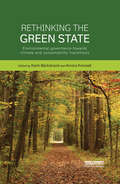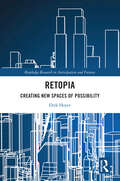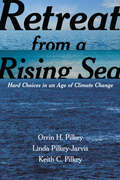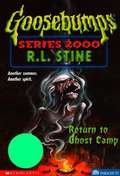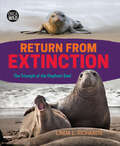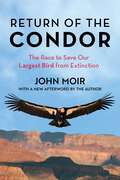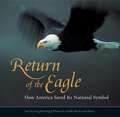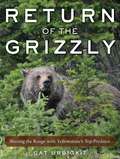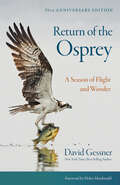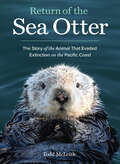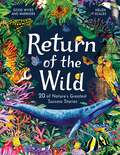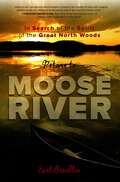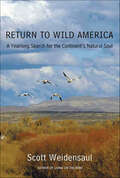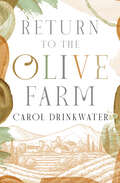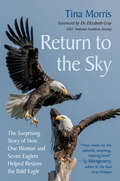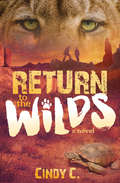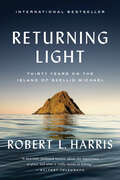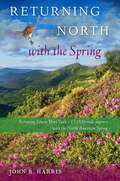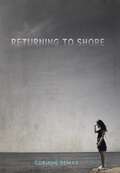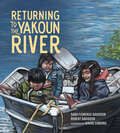- Table View
- List View
Rethinking the Environmental Impacts of Renewable Energy: Mitigation and management
by Alexander ClarkeRenewable energy is important as a substitute for finite fossil fuels and inflexible nuclear power and could conceivably power the world. However, this is challenging as the world is currently 80% dependent on fossil fuels, and renewable sources produce only about 15% of total energy. Conversion technologies for use with many of the eight different primary sources of renewable energy are only just emerging as viable technologies. While renewable energy sources will not run out, and their use involves little or no release of carbon dioxide or ionising wastes, they do have local environmental impacts of their own. This book analyses the nature of environmental impacts from renewable sources. A novel method of assessing impacts is explored based on a set of parameters centred on how diffuse or concentrated the energy flow is. The approach that is developed will inform engineers, designers, policy makers and planners as well as researchers in the area.
Rethinking the Green State: Environmental governance towards climate and sustainability transitions (Routledge Studies in Sustainability)
by Karin Bäckstrand Annica KronsellThis innovative book is one of the first to conduct a systematic comprehensive analysis of the ideals and practices of the evolving green state. It draws on elements of political theory, feminist theory, post-structuralism, governance and institutional theory to conceptualise the green state and advances thinking on how to understand its emergence in the context of climate and sustainability transitions. Focusing on the state as an actor in environmental, climate and sustainability politics, the book explores different principles guiding the emergence of the green state and examines the performance of states and institutional responses to the sustainable and climate transitions in the European and Nordic context in particular. The book’s unique focus on the Nordic countries underlines the important to learn from Nordics, which are perceived to be in the forefront of climate and sustainability governance as well as historically strong welfare states. With chapter contributions from leading international scholars in political science, sociology, economics, energy and environmental systems and climate policy studies, this book will be of great value to postgraduate students and researchers working on sustainability transitions, environmental politics and governance, and those with an area studies focus on the Nordic countries.
Retopia: Creating New Spaces of Possibility (Routledge Research in Anticipation and Futures)
by Dirk HoyerRetopia tells the story of social innovation in times of crisis, and through its cross-disciplinary narrative it goes beyond existing forms of future anticipation and maps out a practice-based approach to the creation of new realities. It explores how new imaginaries, social experiments, and laboratories of societies can create spaces of possibilities, revalidate the peripheries, and create new forms of social coherence. The peripheral regions in Europe are facing a crisis triangle: depopulation, the rise of the ‘useless’ class, and outdated social welfare systems. It is a crisis of political imaginaries and a lack of inspiring political stories. In response to this, the book specifically focuses on the concept of ‘retopia’, the idea of creating inclusive spaces of social innovation that encourage active participation. Through the creation of relocalized societies with a high degree of autonomy in ‘leftover’ spaces, such as Sicily, Western Latvia, or Northern Bulgaria, retopian redevelopment schemes offer new perspectives on ‘ruined spaces’. Retopia uncovers the common links and limitations of utopian studies, future studies, degrowth, narratology, the commons, and political geography. Retopia: Creating New Spaces of Possibility is an articulation of the potentialities of social innovation, political imaginaries, and future images, provoking a stimulating discussion among scholars and students in the fields of Politics and Future and Anticipation Studies.
Retreat from a Rising Sea: Hard Choices in an Age of Climate Change
by Orrin H. Pilkey Linda Pilkey-Jarvis Keith C. PilkeyMelting ice sheets and warming oceans are causing the seas to rise. By the end of this century, hundreds of millions of people living at low elevations along coasts will be forced to retreat to higher and safer ground. Because of sea-level rise, major storms will inundate areas farther inland and will lay waste to critical infrastructure, such as water-treatment and energy facilities, creating vast, irreversible pollution by decimating landfills and toxic-waste sites. This big-picture, policy-oriented book explains in gripping terms what rising oceans will do to coastal cities and the drastic actions we must take now to remove vulnerable populations.The authors detail specific threats faced by Miami, New Orleans, New York, and Amsterdam. Aware of the overwhelming social, political, and economic challenges that would accompany effective action, they consider the burden to the taxpayer and the logistics of moving landmarks and infrastructure, including toxic-waste sites. They also show readers the alternative: thousands of environmental refugees, with no legitimate means to regain what they have lost. The authors conclude with effective approaches for addressing climate-change denialism and powerful arguments for reforming U.S. federal coastal management policies.
Retreat from a Rising Sea: Hard Choices in an Age of Climate Change
by Orrin H. Pilkey Linda Pilkey-Jarvis Keith C. PilkeyThis sobering examination of climate-change and the disastrous effects of rising sea levels explains what must be done to avoid the worst outcomes. By the end of this century, hundreds of millions of people living at low elevations along coasts will be forced to retreat to higher and safer ground. Because of sea-level rise, major storms will inundate areas farther inland and will lay waste to critical infrastructure, such as water-treatment and energy facilities, creating vast, irreversible pollution by decimating landfills and toxic-waste sites. Retreat from a Rising Sea explains in gripping terms what rising oceans will do to coastal cities—detailing the specific threats faced by Miami, New Orleans, New York, and Amsterdam. This policy-oriented book then lays out the drastic actions we must take now to remove vulnerable populations. Aware of the overwhelming social, political, and economic challenges that would accompany effective action, the authors consider the burden to the taxpayer and the logistics of moving landmarks and infrastructure, including toxic-waste sites. They also show readers the alternative: thousands of environmental refugees, with no legitimate means to regain what they have lost. The authors conclude with effective approaches for addressing climate-change denialism and powerful arguments for reforming U.S. federal coastal management policies.
Return To Ghost Camp (Goosebumps Series 2000 #19)
by R. L. StineA big yellow bus roared to a stop in front of our house. The bus doors opened. "Going to Camp Full Moon?" the driver snarled. I raised my eyes to his face -- and screamed. His face was red and swollen -- and covered with fleas. Angry, dark blotches swelled on his forehead -- raw, fresh flea bites, dripping with yellow gunk.
Return from Extinction: The Triumph of the Elephant Seal (Orca Wild #5)
by Linda L. RichardsLess than 100 years ago, the northern elephant seal was thought to be extinct. Today more than 250,000 elephant seals swim in the Pacific Ocean from Alaska to Mexico. In Return from Extinction: The Triumph of the Elephant Seal Linda L. Richards tells the story of their dramatic recovery. Elephant seals were hunted to near extinction for their precious oil before the Mexican government stepped in to protect them. Many people thought it was too late. Even though the life of the elephant seal is difficult and only 20 percent of pups born will make it to adulthood, the species adapted and came back from the brink. They are a true conservation success story.
Return of the Condor: The Race to Save Our Largest Bird from Extinction
by John Moir&“A heart-stopping saga of the rescue from the very brink of extinction of one of the grandest of all birds.&”—Thomas Lovejoy, president of the Amazon Biodiversity Center. RETURN OF THE CONDOR is the riveting account of one of the most dramatic attempts to save a species from extinction in the history of modern conservation. Features a new Afterword by the author.With the condor&’s population down to only twenty-two birds in the 1980s and their very survival in doubt, the condor recovery team flouted conventional wisdom and pursued a controversial strategy to pull the bird back from the brink of extinction. Thus began the ongoing, decades-long program to reestablish America&’s largest bird in its ancient home in Western skies. Award-winning science writer John Moir takes readers into the backcountry to get to know the recovery program scientists as well as some of the individual condors. These are stories of peril, uncertainty, and controversy. Woven throughout these tales of heartbreak and triumph is the extraordinary dedication of the humans who have sometimes risked their lives for this charismatic, intelligent, and social bird. Despite the program&’s remarkable successes, the condor&’s narrative is still unfolding with a number of challenges remaining. This includes the dilemma of lead poisoning among free-flying condors that is a major obstacle to the bird&’s recovery.The new Afterword presents a compelling examination of the progress and continuing adversity facing the condor recovery effort since the first edition of the book was published.Finalist for the William Saroyan International Writing Prize from the Stanford University LibrariesHonorable Mention from the National Association of Science Writers
Return of the Condor: The Race to Save Our Largest Bird from Extinction
by John Moir&“A heart-stopping saga of the rescue from the very brink of extinction of one of the grandest of all birds.&”—Thomas Lovejoy, president of the Amazon Biodiversity Center. RETURN OF THE CONDOR is the riveting account of one of the most dramatic attempts to save a species from extinction in the history of modern conservation. With the condor&’s population down to only twenty-two birds in the 1980s and their very survival in doubt, the condor recovery team flouted conventional wisdom and pursued a controversial strategy to pull the bird back from the brink of extinction. Thus began the ongoing, decades-long program to reestablish America&’s largest bird in its ancient home in Western skies. Award-winning science writer John Moir takes readers into the backcountry to get to know the recovery program scientists as well as some of the individual condors. These are stories of peril, uncertainty, and controversy. Woven throughout these tales of heartbreak and triumph is the extraordinary dedication of the humans who have sometimes risked their lives for this charismatic, intelligent, and social bird. Despite the program&’s remarkable successes, the condor&’s narrative is still unfolding with a number of challenges remaining. This includes the dilemma of lead poisoning among free-flying condors that is a major obstacle to the bird&’s recovery.Finalist for the William Saroyan International Writing Prize from the Stanford University LibrariesHonorable Mention from the National Association of Science Writers
Return of the Eagle: How America Saved Its National Symbol
by Greg BreiningThis is the story of how a nation reversed a &“silent spring&” and saved the bald eagle from extinction. This bird of prey was declared the national symbol in 1782 but, by the 1960s, pollution and development had wiped out all but a few dozen. Grassroots movements started, the American consciousness was raised to all environmental threats, and federal laws were passed to keep the eagle population alive. This stunning book of full-color photographs and touching stories chronicles this inspiring success story with awe-inspiring shots of eagles in flight. There is also a one-of-a-kind directory to more than 150 areas in the nation where eagles are likely to be seen in the wild, soaring once again against the blue skies of freedom. This book is a monument to the efforts that combined animal instinct for survival with the power of the human spirit to change the world.
Return of the Grizzly: Sharing the Range with Yellowstone's Top Predator
by Cat UrbigkitConflicts arise when humans and grizzlies are forced into close quarters.The Yellowstone grizzly population has grown from an estimated 136 bears when first granted federal protection as a threatened species to as many as 1,000 grizzlies in a tri-state region today. No longer limited to remote wilderness areas, grizzlies now roam throughout the region—in state parks, school playgrounds, residential subdivisions, on farms and ranches, and in towns and cities throughout the region. Return of the Grizzly tells the story of the successful effort to recover this large carnivore, the policy changes and disputes between bear managers and bear advocates, and for the first time, provides insight to what recovery means for the people who now live with grizzlies across a broad landscape. From cowboys on horseback chased by a charging grizzly, and grizzlies claiming game animals downed by human hunters, to the numerous self-defense killing of grizzlies that occur each year, the manuscript examines increases in conflicts and human fatalities caused by grizzlies in this ecosystem inhabited by humans who live there year-round. Human–bear interactions, grizzly attacks and deaths, avoiding attacks, effects on agriculture, wildlife protesters, the consequences of bear habituation, and more are all covered.
Return of the Osprey: A Season of Flight and Wonder
by David GessnerA memoir, tribute to a once-endangered species, and natural history, Return of the Osprey recounts the many discoveries David Gessner made when he immersed himself for an entire nesting season in the lives of the ospreys that had returned to his seagirt corner of Cape Cod. The osprey, hailed by Roger Tory Peterson as the symbol of the New England coast, all but vanished during the 1950s and '60s because of the ravages of DDT. In the next few decades, however, the birds returned, slowly at first and then in a rush. Writing with passion, humor, and a reverence for the natural world, Gessner interweaves the stories of the nesting osprey pairs he observed with his own readjustment to life on the windblown, beautiful, and increasingly developed landscape he had known as a child.With a new preface from Gessner and foreword by Helen Macdonald, Return of the Osprey celebrates one of nature's most remarkable creatures, as well as our own limitless capacity for wonder.
Return of the Sea Otter: The Story of the Animal That Evaded Extinction on the Pacific Coast
by Todd McLeishA science journalist's journey along the Pacific Coast from California to Alaska to track the status, health, habits, personality, and viability of sea otters--the appealing species unique to this coastline that was hunted to near extinction in the 18th and 19th centuries.These adorable, furry marine mammals--often seen floating on their backs holding hands--reveal the health of the coastal ecosystem along the Pacific Ocean. Once hunted for their prized fur during the 1700s and 1800s, these animals nearly went extinct. Only now, nearly a century after hunting ceased, are populations showing stable growth in some places. Sea otters are a keystone species in coastal areas, feeding on sea urchins, clams, crab, and other crustaceans. When they are present, kelp beds are thick and healthy, providing homes for an array of sealife. When otters disappear, sea urchins take over, and the kelp disappears along with all of the creatures that live in the beds. Now, thanks to their protected status, sea otters are making a comeback in California, Washington, and Alaska.
Return of the Wild: 20 of Nature's Greatest Success Stories
by Helen ScalesDiscover the extraordinary ways nature has come back from the brink in this collection of 20 environmental success stories from around the world, written by Dr Helen Scales and beautifully illustrated by Good Wives and Warriors. From humpback whale populations thriving again in the freezing seas of Alaska and the recovery of kiwi populations in New Zealand, to the setting up of tiger sanctuaries and reserves in India and return of elephant seals from 'extinction', this book plants a message of hope and shows children that positive change is possible.As well as the 20 recovery stories, Return of the Wild teaches children about the different habitats that animals and plants around the world call home - oceans, forests, deserts and more - and introduces them to the real people supporting endangered species. Finishing off with small tips on what children at home can do to help the wild world, from wearing eco-friendly suncream while swimming in the sea to using less single use plastic, this book reassures children that there are many ways to protect and save our planet from environmental harm.
Return to Moose River: In Search of the Spirit of the Great North Woods
by Earl BrechlinSomeone once asked me how much I charge to guide people into the woods. &“That&’s free,&” I explained. &“Anyone can get themselves into the woods. You pay me to get you out.&” Can anyone really know the northern forest? It is something you feel more in your heart than in your head. You may be able to locate your place on a map, but can you pinpoint the places the forest has hold of your soul? For more than forty years, Maine Guide Earl Brechlin has sought the answers. Through this series of interconnected essays, Brechlin recounts the annual canoe trips to the North Maine Woods he has made with a small group of friends, closing with the death of his twin brother and the group&’s last trip to spread his brother&’s ashes in the place he loved best. Often humorous and thrilling at once, the heartfelt narrative is peppered with tidbits of history, woods lore, and sage advice from a seasoned outdoorsman. What shines through is the author&’s profound love of the natural world and his place in it.
Return to Nature: The New Science of How Natural Landscapes Restore Us
by Emma LoeweDiscover the new science and ancient wisdom on why nature makes us healthier and happier in body and soul from the co-author of The Spirit Almanac and mindbodygreen’s Senior Sustainability Editor.For centuries, we have known that getting outside is good for us. Yet we have become increasingly disconnected from the earth that nourishes us, with most of us spending 87% of our days indoors. In response, writer and environmentalist Emma Loewe demonstrates the power of nature’s healing properties in a guidebook organized by eight landscapes. In each chapter, you'll find research-backed ways to explore that landscape right now and protect it in the future, so that it can be healthy and nurturing for generations to come. Drawing off modern science and innate wisdom, she uncovers: Why being by the ocean makes you measurably happierHow living near greenery helps you lives longerThe staggering, illuminating statistic that forests can make you more relaxed within 90 seconds of walking among trees.Alongside beautiful four-color illustrations that inspire us all to get outside in big and small ways, this stunning book—more urgent than ever—will appeal to anyone looking to connect with the world around them, whether in their neighborhood park or on a backpacking getaway.
Return to Wild America: A Yearlong Search for the Continent's Natural Soul
by Scott WeidensaulIn 1953, birding guru Roger Tory Peterson and noted British naturalist James Fisher set out on what became a legendary journey-a one hundred day trek over 30,000 miles around North America. They traveled from Newfoundland to Florida, deep into the heart of Mexico, through the Southwest, the Pacific Northwest, and into Alaska's Pribilof Islands. Two years later, Wild America, their classic account of the trip, was published. On the eve of that book's fiftieth anniversary, naturalist Scott Weidensaul retraces Peterson and Fisher's steps to tell the story of wild America today. How has the continent's natural landscape changed over the past fifty years? How have the wildlife, the rivers, and the rugged, untouched terrain fared? The journey takes Weidensaul to the coastal communities of Newfoundland, where he examines the devastating impact of the Atlantic cod fishery's collapse on the ecosystem; to Florida, where he charts the virtual extinction of the great wading bird colonies that Peterson and Fisher once documented; to the Mexican tropics of Xilitla, which have become a growing center of ecotourism since Fisher and Peterson's exposition. And perhaps most surprising of all, Weidensaul finds that much of what Peterson and Fisher discovered remains untouched by the industrial developments of the last fifty years. Poised to become a classic in its own right, Return to Wild America is a sweeping survey of the natural soul of North America today.
Return to the Olive Farm (The Olive Farm Series)
by Carol DrinkwaterAt a small farm in Provence, a woman tries to do her part to save the bees—and the planet—in this stirring, entertaining memoir. After a long research trip, Carol Drinkwater is back home with her husband, Michel, on their olive farm in the south of France. She&’s overjoyed, but also has something serious on her mind: the ecological threats to their own farm—and countless others. The die-off of honey bees has reached crisis levels globally, and Carol is concerned about the state of their hives. Some farmers and scientists believe urgent change is needed to address agricultural techniques that are destroying the planet. But when Carol joins their chorus, it may put their beloved farm in jeopardy. It&’s time for a true commitment—but running an organic farm, the couple soon discovers, is not as simple as it sounds . . .Praise for the Olive Farm series &“Vibrant, intoxicating and heartwarming.&” —Sunday Express &“Spellbinding . . . a must for anyone who dreams of moving to a kinder climate and starting a new life.&” —Choice
Return to the Sky: The Surprising Story of How One Woman and Seven Eaglets Helped Restore the Bald Eagle
by Tina Morris&“Three cheers for this splendid, surprising, inspiring book!&”—Sy Montgomery, author of The Soul of an OctopusAlone in a vast wildlife refuge with little direction and no experience, a Cornell Laboratory of Ornithology student found herself responsible for a project of historical importance—to bring the Bald Eagle back from near extinction.In Return to the Sky, Tina Morris, one of the first women to engage in a raptor reintroduction program, shares her remarkable story that is as much about the human spirit as it is about birds of prey.In the spring of 1975, on the eve of the US Bicentennial, Tina was selected to reintroduce Bald Eagles into New York State in the hope that the species could eventually repopulate eastern North America. Young and female in a male-dominated field, Tina was handed an assignment to rehabilitate a population that had been devastated by the effects of DDT. The challenges were prodigious—there was no model to emulate for a bird of the eagle&’s size, for one—but Tina soon found that her own path to self-discovery and confidence-building was deeply connected with the survival of the species she was chosen to protect.Ultimately, Tina spent two years playing &“mother&” to seven eaglets at Montezuma National Wildlife Refuge, east of Seneca Falls in New York. Driven by her passion, she discovered unknown reserves of patience, determination, and grit.At a time when the mass extinction of bird species is a critical global topic, Return to the Sky reminds us how, with a mix of common sense, resilience, and resolve, humans can be effective stewards of the natural world.&“Inspiring . . . [and] proof that one determined person can still make a difference. At a time when the mass extinction of bird species is a critically important global topic, Dr Morris reminds us that humans can still be effective guardians of the natural world.&”—Forbes&“Emotional and inspiring proof that one person can make a difference.&”—Kirkus Reviews&“Inspiring . . . the writing is clear and eloquent . . . Morris expertly blends moving memoir and scientific research in this remarkable and affecting story.&”—Booklist
Return to the Wilds: A Novel
by Cindy C.Return to the Wilds is a dystopian fantasy with environmental and spiritual overtones that contrasts the unintended effects of urbanization and development with the simplicity and healing of the natural world.Keren, a pre-teen activist and biologist, and Caleb, Kerens mystic sidekick, seek to save the last remnants of nature in a world focused on progress, prosperity, and conformity. When the gates slide open on Purity Mountain Wild, Keren is shocked. No Automated Elevation Systems whisking people to individually keyed destinations; they hike a trail into forested mountains. No Hearing Enhancement Audio Devices (HEADs) to block machine screams and voices; her ears fill with bird calls, thumping feet and breathy wind in the tall overhead pines. Guided by a mysterious Keeper and helped by Wildlings, Keren, Caleb, and their friends must use wit and geek skills to outwit underlings of the ominous Dominion and make a powerful pitch for changing the story of human progress.Return to the Wilds offers a unique world view on institutional forces, security and development, the courage and clarity of youth, and the intangible power of the wild and natural. At a somewhat dismal time when young people again are questioning failed institutions of their elders and contending for the planet, it offers new perspective on whats broken, what to do, and where hope and help can be found.
Return: A Journey Back to Living Wild
by Lynx VildenIn this stunning memoir, beloved internationally acclaimed earth advocate chronicles her journey to reconnect with the earth, offering a model for how we all can nurture the wild around and inside ourselves.In 1991, twenty-four-year-old Lynx Vilden crawled out of a sweat lodge covered in mud, her face streaked with tears, and whispered a promise to the earth: “I will love you and cherish you, I will learn how to live and share what you teach me.” That promise became Vilden’s life purpose: to return to the ways of our oldest ancestors, to a simpler life, and to listen deeply to Earth and what she has to say. Over the next thirty years, Vilden’s mission would lead her far from the city streets and punk bands of London and Amsterdam where she was raised, on a long and winding journey spanning continents and seasons, and filled with indigenous wisdom, Stone Age hunting skills, and important lessons from nature.In this illuminating memoir, Vilden shares the joys that await all of us when we reconnect with the earth, when we recognize what has been lost, and understand what we gain by meaningfully returning to our roots and become rewilded. Return is a glimpse into her extraordinary world—from stories about mentoring Silicon Valley millennials at her Stone Age immersion in rural Washington State to adventures traveling among Sami reindeer herders in Arctic Sweden to detailing the intricacies of just how to pursue and survive a wild lifestyle inspired by Stone Age humans.This extraordinary debut ultimately invigorates our hunger to renew our bonds with the earth and awaken our wildest, most primal selves.
Returning Light: Thirty Years on the Island of Skellig Michael
by Robert L. HarrisThe Acclaimed International Bestseller "Reading Returning Light is a spiritual experience." —Irish ExaminerBy the lighthouse keeper on the remote, otherworldly Irish island of Skellig Michael, a "profound memoir about the importance of place and what it really means to belong" (Belfast Telegraph)“On Skellig Michael, thousands of birds appear and disappear, erecting towers, coming together in wings of movement which build and unravel over the empty sea. Often, no one else is there to stand beside me on the island. The mind wanders; links with the past are easily made; ancient ways of viewing things come alive.”In 1987, Robert Harris happened upon an unusual job posting in the local paper—a new warden service was being set up on the island of Skellig Michael, and the deadline was imminent. Just weeks later he was on his way to set up camp in one of Ireland’s most remote locations, unaware that he would be making that same journey every May for the next 30 years.Here he transports us to the otherworldly island, a place that is teeming with natural life, including curious puffins that like to visit his hut. From the precipice he has observed a coastline that is relatively unchanged for the last thousand years—a beacon of equilibrium in an ever-changing world.But the island can be fierce too. It’s inhabitable for only five months of the year, and solitude can quickly become isolation as bad weather rolls in to create a veil between Skellig Michael and the rest of the world, when the dizzying terrain can become a very real threat to life.A beautiful and evocative work of nature writing, Returning Light is an extraordinary memoir about the profound effect a place can have on us, and how a remote location can bring with it a great sense of belonging.
Returning North with the Spring
by John R HarrisAt winter's end in 1947, driven by the devastating loss of a son killed in World War II, naturalist Edwin Way Teale followed the dawning spring season northward in an amazing 17,000-mile odyssey from the Everglades to Maine. He wrote about the adventure in North with the Spring. Its sequel Wandering Through Winter won the Pulitzer Prize.Retracing Teale's route, writer John Harris reveals a vastly changed natural world. In Returning North with the Spring, he stops at the very places where Teale once stood, trekking through the Okefenokee wetland, the Great Smoky Mountains, the Great Dismal Swamp, the New Jersey Pine Barrens, and Cape Cod. He is stunned to see how climate change, invasive species, and other factors have affected the landscapes and wildlife. Yet he also discovers that many of the sites Teale described have been newly "rewilded" or permanently protected by the government.Homage to the past, report on the present, glimpse into the future--this book honors what has been lost in the years since Teale's famous journey and finds hope in the small tenacities of nature.
Returning to Shore
by Corinne DemasHer mother's third marriage is only hours old when all hope for Clare's fifteenth summer fades. Before she knows it, Clare is whisked away to some ancient cottage on a tiny marsh island on Cape Cod to spend the summer with her father—a man she hasn't seen since she was three. Clare's biological father barely talks, and when he does, he obsesses about endangered turtles. The first teenager Clare meets on the Cape confirms that her father is known as the town crazy person. But there's something undeniably magical about the marsh and the island—a connection to Clare’s past that runs deeper than memory. Even her father's beloved turtles hold unexpected surprises. As Clare's father begins to reveal more about himself and his own struggle, Clare's summer becomes less of an exile and more of a return.
Returning to the Yakoun River (Sk'ad'a Stories Series)
by Robert Davidson Sara Florence DavidsonBased on author Sara Florence Davidson&’s childhood memories, this illustrated story captures the joy and adventure of a Haida fish camp.Every summer, a Haida girl and her family travel up the Yakoun River on Haida Gwaii, following the salmon. While their father fishes, the girl and her brother spend their time on the land playing and learning from Tsinii (Grandfather).

